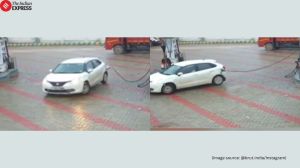67 per cent public transport users change mode of travel due to last mile connectivity issues in Ahmedabad, finds a study by CEPT University students
The project was displayed at the CEPT Winter Exhibition 2024 which was inaugurated Monday evening and will continue till December 6.
 The transport choices based on job type revealed that people working as labourers prefer walking an average of 2.6 km daily. (File Photo)
The transport choices based on job type revealed that people working as labourers prefer walking an average of 2.6 km daily. (File Photo)Due lack of last mile connectivity, 67 per cent trips on public transport require the passengers to change their mode of travel, leading to a low ridership in Ahmedabad city, according to a study by the CEPT University students.
Lack of different modes of transportation (multi-modal integration), people’s choices based on their jobs and income are other factors affecting the travel pattern, states the survey.
The study conducted by varsity’s postgraduate students is based on a perception survey of 2,400 people, public transport connectivity survey of 720 people, qualitative in-depth interviews, choice based interviews of 240 people along with journey experiences of 90 people.
The project was displayed at the CEPT Winter Exhibition 2024 which was inaugurated Monday evening and will continue till December 6. The biannual exhibition showcases the work of 1,720 students across 109 studio units, from its Monsoon 2024 semester.
It displays work from undergraduate and postgraduate studios across six faculties, including Architecture, Design, Management, Planning, Technology and the CEPT Foundation Programme (CFP).
“This time, we looked at the issue of why people are not using public transport instead of public versus private transport. So, we surveyed the commuters using the public transport, for how much time they are using it, whether there is last mile connectivity for them and what is the choice of transport on the basis of employment,” Prof Nitika Bhakuni from Faculty of Planning told The Indian Express.
The issues shared in using the public transport by commuters and residents included encroachment by street vendors and others along the footpath as majority of them are less than 1.5 m wide, poor quality of footpaths and very few shaded footpaths.
The study conducted by 151 students revealed that 50 per cent of the total travel time spent in access and egress (physically entering and exiting a place), first and last mile of which more than 10 minutes is the average waiting time. Also, the cost of using public transport is half of private transport but takes twice the duration, according to the study.
The transport choices based on job type revealed that people working as labourers prefer walking an average of 2.6 km daily while those into the job sector commute an average of 6.7 km by two wheeler and students commute an average 4.7 km by two wheeler on a daily basis.
“The multi-modal transport study reveals lack of first and last mile connectivity. Lack of public transport such as buses also result in a longer waiting time,” Prof Rutul Joshi said.
Further, on the outcomes of the surveys, Prof Bhakuni added, “People are looking for quality public transport. If you want a choice user to shift to public transport you need to give them quality services along with real time information.”
Income and travel characteristics revealed that those earning above Rs 1 lakh per month travel 6.2 km while those below Rs 10,000 income per month travel an average of 1.5 km. One fourth of the travel trips are to variable job locations against fixed job locations.
Explaining the study, Prof Bhakuni said, “Four types of surveys were used by the students — Google maps journey, actual journey taken, in-depth household interviews, commuter surveys of both users and non users of public transport”.
“At least 12 locations across the city with major loads from old as well as new urban areas were identified for the study,” said Bhakuni.












